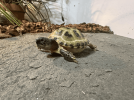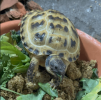You don't need to buy anything. Just use something around the house with a known weight. For example: Four quarters weigh 22.68 grams.Currently using this to weigh Sandy. Need to buy those weights to test to make sure scale is accurate. So many things to do each day and the day just fly's!
View attachment 369783
You are using an out of date browser. It may not display this or other websites correctly.
You should upgrade or use an alternative browser.
You should upgrade or use an alternative browser.
Setting up for a Russian Tortoise - Constructive comments welcome
- Thread starter David Steere
- Start date
A nickel weighs 5 grams and a 1 dollar bill weighs 1 gram........Easy as that, no need for special weights to calculate. Nickels and dollars differ minutely, get a nickel that you use always and that is how you'll know if it's accurate. Don't tip your scale upside down or toss it around and you'll have no issues with accuracy. You should as well "Zero" your scale after each use, just an extra step to ensure it's always right.You don't need to buy anything. Just use something around the house with a known weight. For example: Four quarters weigh 22.68 grams.
In weighing our Jo Jo i tried to weigh at the same time of day always, before any soaking or eating first thing in the morning. There would be a little variation (Pee) but it worked out quite well.
The_Four_Toed_Edward
Active Member
Tortoises can get fat. A fat tortoise will have visible over hang on the back and front. Their limbs might be "puffy" and they will have trouble retracting in to the shell. Here is a link to a old thread with pictures of a overweight Russian tortoise: https://tortoiseforum.org/threads/overweight-tort-what-to-look-for.5311/ I bet you will notice if yours is getting overweight, though I doubt it will in your care@Tom @Alex and the Redfoot @wellington
Sorry if this is a stupid question. Just came up this morning.
Is there a rule of thumb for tortoise weight?
Every two weeks after the soak at the same time of day I am going to weigh Sandy.
May 17, 2024 = 45 1/2 grams <- Arrived
May 28, 2024 = 54 1/2 grams
She gained 9 grams.
I guess I just want to know what should I be looking for as a benchmark every two weeks.
- Do tortoise weights fluctuate?
- Should tortoises always gain weight?
- Is it a problem if they lose weight? Assume you would see other symptoms.
- Can tortoises eat to much? Get fat? Is that good?
I think you'd like a cell phone if you start simple with a halfway decent camera in it . It looks like you'll have grands to help you with it. The camera is my favorite thing on a cell phone. And maybe start simple with your plants too. First plant things you know your little Russian likes and add more as you get to know the darling. If you plant some of the suggestions just plant maybe a couple of each at first. My Russian is a picky little person. I have opuntias he doesn't like. Aloe he doesn't like. Rose of Sharon he doesn't like etc etc etc if you see what I mean. It won't hurt to have safe plants in the enclosure but if you want edibles you'll have to figure out what the little one likes. They do have their own favorites.I do not have a camera or have yet to ever own a cell phone. Relying on my grandkids for pictures.
Working on getting a device soon. Pictures incoming soon.
David Steere
Member
_The_Beast_
Active Member
Swoon! Sandy is such a cutie 😍 Thank you to you and your granddaughter for the pics 🥰
It is not common and many, if not most, cases of "fat" tortoises are actually edema, not adipose tissue. We see that frequently with young sulcatas here on the forum. "Is my tortoise fat?" is the question we get, while looking at a picture of a baby showing edema.Tortoises can get fat. A fat tortoise will have visible over hang on the back and front. Their limbs might be "puffy" and they will have trouble retracting in to the shell. Here is a link to a old thread with pictures of a overweight Russian tortoise: https://tortoiseforum.org/threads/overweight-tort-what-to-look-for.5311/ I bet you will notice if yours is getting overweight, though I doubt it will in your care
Did you read the thread you linked? Looks like the tortoise's carapace failed to keep up with the rest of its body for some reason. It looked fat because its carapace was too small. That sort of thing can happen when people don't care for them correctly. That tortoise was a rescue, so no one knows what happened to it to make it look like that. That is one example from 2008. I don't recall seeing other examples in the 14 years I've been on the forum, and I've seen no examples in my travels around the world either. As I stated previously, it IS possible with incorrect diet, temperatures and housing to make one get fat, but it is exceedingly rare.
Last edited:
The_Four_Toed_Edward
Active Member
Yes you are right, fat tortoises are extremely rare and usually come from rescue scenarios with improper growth and diet (like Russians being fed canned cat food or something bizarre, being overweight is not the only problem at that point). So I read the thread I linked, but I guess my English skills aren't always on point when I am trying to get my message acrossIt is not common and many, if not most, cases of "fat" tortoises are actually edema, not adipose tissue. We see that frequently with young sulcatas here on the forum. "Is my tortoise fat?" is the question we get, while looking at a picture of a baby showing edema.
Did you read the thread you linked? Looks like the tortoise's carapace failed to keep up with the rest of its body for some reason. It looked fat because its carapace was too small. That sort of thing can happen when people don't care for them correctly. That tortoise was a rescue, so no one knows what happened to it to make it look like that. That is one example from 2008. I don't recall seeing other examples in the 14 years I've been on the forum, and I've seen no examples in my travels around the world either. As I stated previously, it IS possible with incorrect diet, temperatures and housing to make one get fat, but it is exceedingly rare.
I also should have said that swollen limbs and inability to retrieve into the shell is usually caused by other health issues and it is a symptom every tortoise parent will probably notice...
David Steere
Member
Another question. Just want to get an idea from everyone's experience.
A question a day keeps the doctors away I guess.
With a current 48"x72" enclosure and with a 2 1/2" tortoise long how often would everyone think a COMPLETE enclosure change would be required?
A question a day keeps the doctors away I guess.
With a current 48"x72" enclosure and with a 2 1/2" tortoise long how often would everyone think a COMPLETE enclosure change would be required?
- Do you think 3 months, 6 months, 9 months, 12 months or even more?
- Currently Sandra usually pee's once, and pops like 3 or 4 times when soaking in the morning. Spot check enclosure and only notice pee and poop near food dish. But sure I could miss finding anything.
- Not sure how the got into enclosure but I have noticed Pillbugs are present. My understanding is that they are a natural "Cleanup The Enclosure" bug is that correct?
- I just want to make sure Sandy always has a nice place to live and I do not create a toxic environment by thinking things look great but under the surface they are not great but terrible for Sandy.
Alex and the Redfoot
Well-Known Member
1. It depends. But usually with timely spot cleaning it's a year or more. As Sandy grows you might want to switch coco coir for orchid bark, probably there is no need to do it earlier.
2. I doubt, you will miss any "landmines" - they smell strong enough not to be missed. Also, you may do a substrate "turnover" (once in 1-2 months), mixing bottom and top layers and handpacking again. During soaks maybe the most suitable time.
3. Yes, they are fine to have in substrate and springtails too. Some keepers put them on purpose, so you are lucky
4. That's what we all try to do - to do the best and avoid harm. There some definite reasons for substrate change - parasites and mold. With a good care both are unlikely.
2. I doubt, you will miss any "landmines" - they smell strong enough not to be missed. Also, you may do a substrate "turnover" (once in 1-2 months), mixing bottom and top layers and handpacking again. During soaks maybe the most suitable time.
3. Yes, they are fine to have in substrate and springtails too. Some keepers put them on purpose, so you are lucky
4. That's what we all try to do - to do the best and avoid harm. There some definite reasons for substrate change - parasites and mold. With a good care both are unlikely.
The_Four_Toed_Edward
Active Member
Do you mean when your tortoise will be needing a bigger enclosure?With a current 48"x72" enclosure and with a 2 1/2" tortoise long how often would everyone think a COMPLETE enclosure change would be required?
David Steere
Member
No I mean get the old substrate out, sterilize and replace with new.Do you mean when your tortoise will be needing a bigger enclosure?
Similar threads
- Replies
- 9
- Views
- 3K

